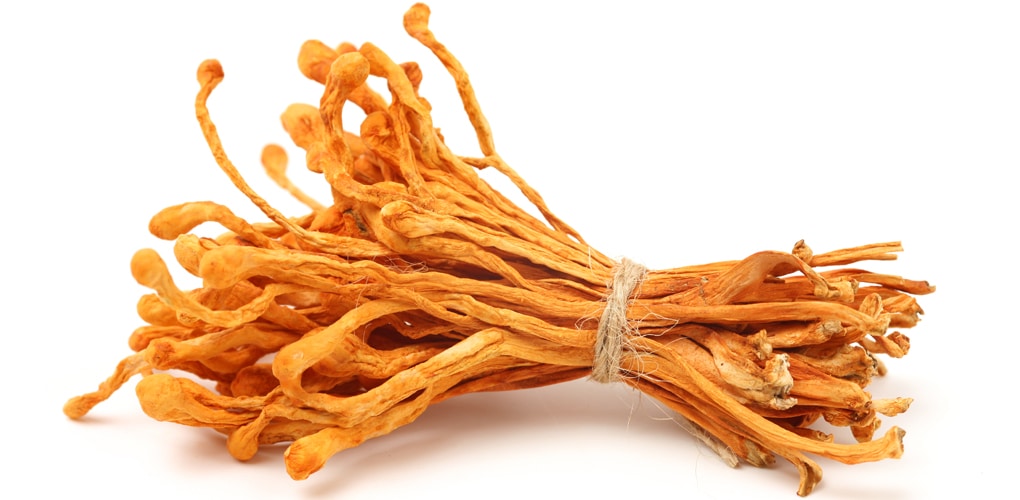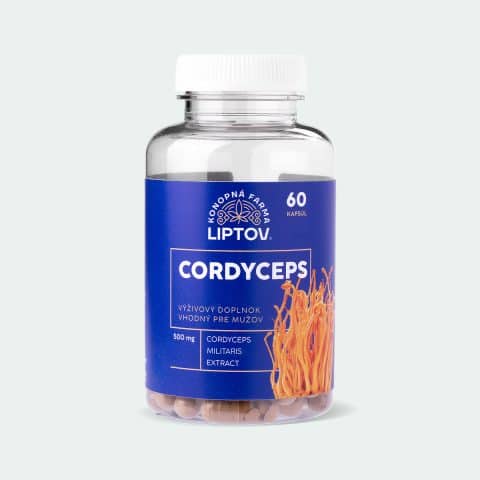Cordyceps – what is it actually and what effects does it have?

If you are a lover or practitioner of Chinese medicine, chances are that you are already familiar with Cordyceps, also called “Chinese Caterpillar” or “Himalayan Gold”. However, if you belong to the second group, who have no idea what it is all about, in this article you will learn everything important about Cordyceps. Medicinal mushrooms have been known for thousands of years for their healing effects in various diseases. And the parasitic fungus Cordyceps is one of them.
What is it all about?
Medicinal mushroom from Chinese medicine
Cordyceps belongs to the class of pocket fungi. These are made up of a single-celled stem or filamentous mycelium and form pockets where their haploid spores (by which they reproduce) are found. Over 600 species of Cordyceps are known, most of which are classified as endoparasites. This means that the fungus parasitizes inside the bodies of insects or arthropods. Specifically, the Chinese Caterpillar parasitizes most butterfly larvae, whose tissues are gradually replaced by those of the fungus. It is native to Asia and its effects have been abundantly described in ancient Chinese and Tibetan medicine. It thrives in the cool, moist and grassy environment of the Himalayas, which stretch across the Tibetan plateau.

Zombie parasite
In winter, the fungus attacks the brain of the larva and “commands” it to crawl to the surface of the dirt. There, the fungus grows out of the larva’s head and forms spores above the ground, which it uses to reproduce and infect other larvae. Between around April and May the larvae slowly die and the fungus can be seen low to the ground. This period is also called the ‘caterpillar fungus’ season. Cordyceps collectors thoroughly search the ground surface and carefully dig out the fungus embedded in the larva. The price of wild Cordyceps climbs very high and harvesting it is difficult because of its small size. In 2017, a kilo of Cordyceps sold for US$140,000 in Beijing (1).
In recent years, the occurrence of Cordyceps in nature has decreased significantly. Studies link this to climate change and warmer winters, when the fungus does not fare as well as it does in cold weather. Another reason is excessive demand and harvesting (2). This is why Cordyceps for medicinal use is now also cultivated in laboratories on various nutrient-containing solutions, on silkworm larvae or on cereal grains.
Cordyceps and its medicinal effects
Everything from the Himalayas
Cordyceps has deep roots in traditional Chinese medicine. According to traditional healers and residents of the North Indian state of Sikkim, Cordyceps is recommended for all ailments, with the strongest effects on longevity, libido, fatigue, liver and kidney diseases. In Nepal, it has also been attributed with positive effects in treating diarrhoea, headache, cough and rheumatism.
Modern studies have confirmed the positive effects of Cordyceps and its products on the liver, kidneys, cardiovascular, respiratory nervous, immunological and reproductive systems. At the same time, Cordyceps has shown a high content of antioxidants, unsaturated fatty acids, a variety of nutrients including essential oils, vitamins B1, B2, B12 and K, carbohydrates, but also proteins, sterols and nucleosides. Many studies have also confirmed its antibacterial, antifungal, anti-inflammatory, antidiabetic, anticancer, prosexual, immunomodulatory, and anti-HIV effects (3).
It is claimed to improve physical stamina and is therefore suitable for the elderly and athletes. It also has a long history in the treatment of kidney and liver diseases, bronchitis, asthma, tuberculosis and other respiratory diseases. As for cardiovascular disease, Cordyceps helps lower blood pressure. Studies have also shown an improvement in heart performance of up to 60% when Cordyceps is taken for diseases with impaired heart function. Moreover, it reduces blood viscosity and thus prevents heart attacks. It is worth mentioning its active ingredient cordycepin which interacts with various biological and biochemical processes such as DNA and RNA formation (3).

Medical recommendations
In general, Cordyceps is considered a safe non-toxic mushroom. As far as side effects are concerned, they have been observed, for example, diarrhea, nausea, dry mouth, or allergic reaction. It is not recommended for patients suffering from autoimmune diseases (rheumatoid arthritis, systemic lupus, multiple sclerosis), people with intolerance or allergy to mushrooms and also pregnant and breastfeeding women due to insufficient research (3). It is also inappropriate to take Cordyceps for acute problems (e.g. fever, diarrhoea or inflammation) (1). Before taking the mushroom, it is important to consult your doctor because it may work poorly in combination with other medications you are taking.
Sources:
(1) Cordyceps, Caterpillars (video) Lekarnik.online https://www.youtube.com/watch?v=umnXxaFC_Fk
(2) Panda A. K. and Swain K. CH. (2011). Traditional uses and medicinal potential of Cordyceps sinensis of Sikkim. NCBI. https://www.ncbi.nlm.nih.gov/pmc/articles/PMC3121254/
(3) Tuli, H. S. et al. (2013) Pharmacological and therapeutic potential of Cordyceps with special reference to Cordycepin. 3 Biotech. [Online] 4 (1), 1-12. https://pmc.ncbi.nlm.nih.gov/articles/PMC3909570/
Cordyceps in the article
-
 Cordyceps – dietary supplement19,80 €
Cordyceps – dietary supplement19,80 €19,90 €

